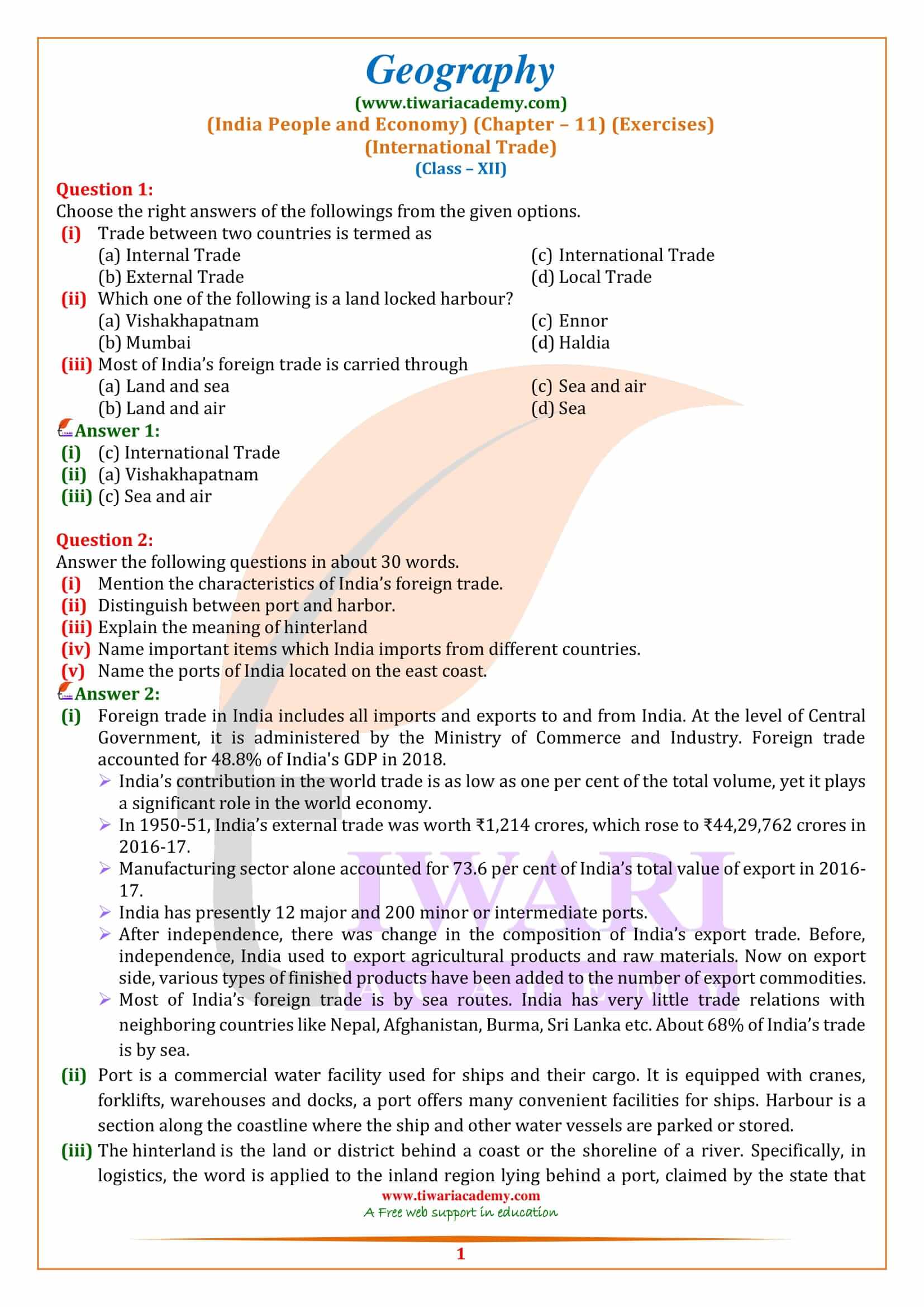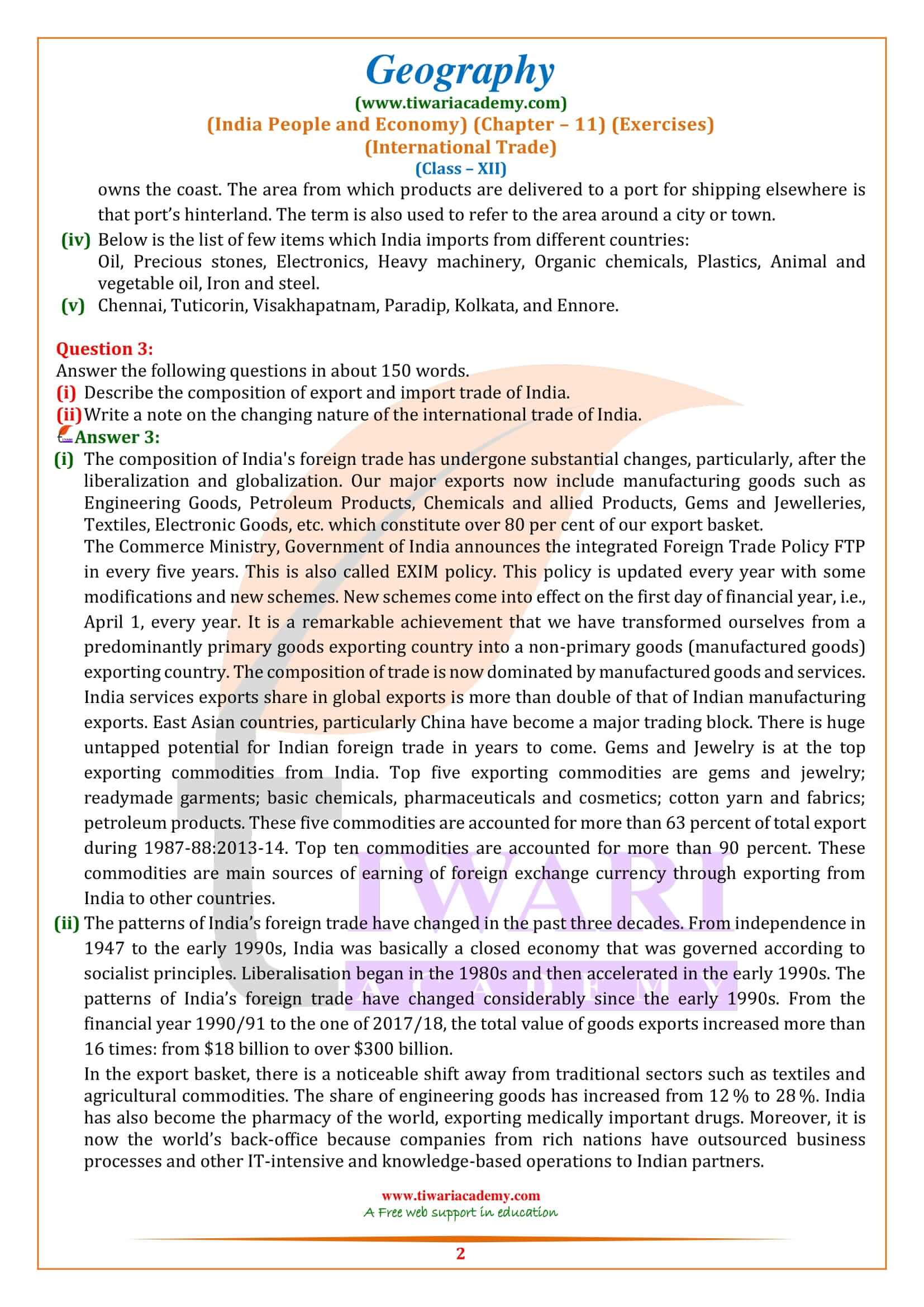NCERT Solutions for Class 12 Geography Chapter 11 International Trade in Hindi and English Medium updated for CBSE 2025-26. In India People and Economy Unit VI, the chapter 11 of class 12 Geography are explained here with extra short and long question answers.
NCERT Solutions for Class 12 Geography Chapter 11
Class 12 Geography Chapter 11 International Trade Question Answers
- Class 12 Geography Chapter 11 NCERT Solutions
- Class 12 Geography Chapter 11 MCQ with Answers
- Class 12 Geography Chapter 11 Important Questions
- Class 12 Geography Chapter 11 Hindi Medium
- Class 12 Geography Chapter 11 NCERT Book
- Class 12 Geography all Chapters Solutions
- Class 12 all Subjects NCERT Solutions
Mention the characteristics of India’s foreign trade.
Foreign trade in India includes all imports and exports to and from India. At the level of Central Government, it is administered by the Ministry of Commerce and Industry. Foreign trade accounted for 48.8% of India’s GDP in 2018.
- India’s contribution in the world trade is as low as one per cent of the total volume, yet it plays a significant role in the world economy.
- In 1950-51, India’s external trade was worth ₹1,214 crores, which rose to ₹44,29,762 crores in 2016-17.
- Manufacturing sector alone accounted for 73.6 per cent of India’s total value of export in 2016-17.
- India has presently 12 major and 200 minor or intermediate ports.
- After independence, there was change in the composition of India’s export trade. Before, independence, India used to export agricultural products and raw materials. Now on export side, various types of finished products have been added to the number of export commodities.
- Most of India’s foreign trade is by sea routes. India has very little trade relations with neighboring countries like Nepal, Afghanistan, Burma, Sri Lanka etc. About 68% of India’s trade is by sea.
Distinguish between port and harbor.
Port is a commercial water facility used for ships and their cargo. It is equipped with cranes, forklifts, warehouses and docks, a port offers many convenient facilities for ships. Harbour is a section along the coastline where the ship and other water vessels are parked or stored.
Explain the meaning of hinterland.
The hinterland is the land or district behind a coast or the shoreline of a river. Specifically, in logistics, the word is applied to the inland region lying behind a port, claimed by the state that owns the coast. The area from which products are delivered to a port for shipping elsewhere is that port’s hinterland. The term is also used to refer to the area around a city or town.
Class 12 Geography Chapter 11 MCQ
Trade between two countries is termed as
Which one of the following is a land locked harbour?
Most of India’s foreign trade is carried through
Name important items which India imports from different countries.
Below is the list of few items which India imports from different countries:
Oil, Precious stones, Electronics, Heavy machinery, Organic chemicals, Plastics, Animal and vegetable oil, Iron and steel.
Name the ports of India located on the east coast.
Chennai, Tuticorin, Visakhapatnam, Paradip, Kolkata, and Ennore.
Describe the composition of export and import trade of India.
The composition of India’s foreign trade has undergone substantial changes, particularly, after the liberalization and globalization. Our major exports now include manufacturing goods such as Engineering Goods, Petroleum Products, Chemicals and allied Products, Gems and Jewelleries, Textiles, Electronic Goods, etc. which constitute over 80 per cent of our export basket.
The Commerce Ministry, Government of India announces the integrated Foreign Trade Policy FTP in every five years. This is also called EXIM policy. This policy is updated every year with some modifications and new schemes. New schemes come into effect on the first day of financial year, i.e., April 1, every year. It is a remarkable achievement that we have transformed ourselves from a predominantly primary goods exporting country into a non-primary goods (manufactured goods) exporting country. The composition of trade is now dominated by manufactured goods and services. India services exports share in global exports is more than double of that of Indian manufacturing exports. East Asian countries, particularly China have become a major trading block. There is huge untapped potential for Indian foreign trade in years to come. Gems and Jewelry is at the top exporting commodities from India.
Top five exporting commodities are gems and jewelry; ready-made garments; basic chemicals, pharmaceuticals and cosmetics; cotton yarn and fabrics; petroleum products. These five commodities are accounted for more than 63 percent of total export during 1987-88:2013-14. Top ten commodities are accounted for more than 90 percent. These commodities are main sources of earning of foreign exchange currency through exporting from India to other countries.
Write a note on the changing nature of the international trade of India.
The patterns of India’s foreign trade have changed in the past three decades. From independence in 1947 to the early 1990s, India was basically a closed economy that was governed according to socialist principles. Liberalisation began in the 1980s and then accelerated in the early 1990s. The patterns of India’s foreign trade have changed considerably since the early 1990s. From the financial year 1990/91 to the one of 2017/18, the total value of goods exports increased more than 16 times: from $18 billion to over $300 billion.
In the export basket, there is a noticeable shift away from traditional sectors such as textiles and agricultural commodities. The share of engineering goods has increased from 12 % to 28 %. India has also become the pharmacy of the world, exporting medically important drugs. Moreover, it is now the world’s back-office because companies from rich nations have outsourced business processes and other IT-intensive and knowledge-based operations to Indian partners.



